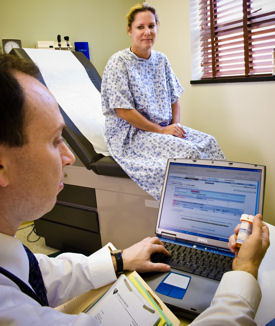Endo ‘08: new research ignites debate about best A1C goals
From diabetes and dyslipidemia to hormones and hirsutism, the Endocrine Society's 90th annual meeting in San Francisco last June was a wellspring of new information and fresh debate.
SAN FRANCISCO—From diabetes and dyslipidemia to hormones and hirsutism, the Endocrine Society's 90th annual meeting in San Francisco last June was a wellspring of new information and fresh debate.
Ioanna Gouni-Berthold, MD, professor of medicine at University of Cologne, Germany, grabbed headlines with her study that found women with type 2 diabetes and heart disease get less intensive medical treatment for, and have poorer control of, these conditions than men.
In the study of nearly 45,000 diabetics, comorbid women were 44% more likely than comorbid men to have high LDL cholesterol, but 15% less likely to get lipid-lowering medication. The women were also 19% more likely to have uncontrolled hypertension, and 15% more likely to have poor long-term control of their blood glucose levels.
The findings may explain why death from heart disease has decreased among diabetic men in the past 25 years, but hasn't decreased for diabetic women, Dr. Gouni-Berthold said.
There was good news for diabetics, too. A study unveiled at the meeting found that for obese and overweight men with type 2 diabetes, moderate fitness levels lowered the risk of all-cause death by 40%-50% at seven-year follow up.
By measuring peak metabolic rate on 2,690 male diabetics during a standard treadmill exercise tolerance test, researchers classified fitness levels as low, moderate or high. Moderate fitness reduced death risk by 40% in healthy-weight and overweight men, and 52% in obese men, while high fitness level reduced death risk by 60% in healthy-weight men, and 65% in overweight men.
“Diabetics should improve their fitness or exercise capacity to at least a moderate level,” said study co-author Roshney Jacob-Issac, MD, an endocrinology fellow at George Washington University Hospital. “Weight loss is great but being active is just as important.”
Diabetes debate
Release of the ADVANCE trial results days before the conference sparked debate about the proper target for glycemic control. ADVANCE, which was published in the June 12 New England Journal of Medicine (NEJM), found that intensive glucose control (6.5% glycated hemoglobin or less) didn't improve vascular outcomes or mortality for type 2 diabetics more than a control of about 7.3%—and it actually led to a higher rate of severe hypoglycemia.
Lois Jovanovic, MD, CEO and chief scientific officer of the Sansum Diabetes Research Institute in Santa Barbara, Calif., said the target should be less than 6.5%. She acknowledged that hypoglycemia and weight gain are risks of using this lower target, but said the risks can be managed with careful attention by doctor and patient, and they don't outweigh the scientific evidence supporting intensive glucose control.
She noted that the Diabetes Control and Complications Trial (DCCT) in 1993 found that, in order to lower the risk of microvascular complications among type 1 diabetics to that of the general population, the A1c target needed to be below 6%.
“We recognize the risks and therefore we can [lower A1c below 6.5%] safely” with measures like continuous glucose sensing and a feedback control system, Dr. Jovanovic said.
Co-debater Richard M. Bergenstal, MD, executive director of the International Diabetes Center at Park Nicollet in Minneapolis, conceded that physicians should use a goal of less than 6.5% for pregnant women with diabetes, but said most other patients should have a goal of 7%.
That's because data from the ADVANCE study and the VA Diabetes Trial (VADT), released in June, showed the A1c level reached in the intensive treatment arm was between 6.5% and 6.9% with benefits in microvascular disease and no harm seen in cardiovascular outcomes. Yet the ACCORD trial also published in the June 12 NEJM showed a mortality increase when patients at high risk for cardiovascular disease and out-of-control diabetes tried to reach an A1c of less than 6% (and actually achieved an A1c of 6.4%).
Strict regimens can also add considerable stress to the life of a person with diabetes, and these regimens demand more of a physician's time, he added.
“(Using a 7% target) will allow us the time, energy and resources to find answers to improve blood pressure and lipid levels—as well as aspirin use—and to get the A1c as close to normal as possible in pregnant women with diabetes,” Dr. Bergenstal said.
The power of testosterone
Testosterone had a moment or two in the spotlight, as several studies indicated dire consequences for men who lack adequate amounts of the hormone. One study suggested that men who report erectile dysfunction should be screened for testosterone deficiency and metabolic syndrome, as the conditions often occur together.
The trial examined 771 men who sought treatment for erectile dysfunction and found 18.3% of men had testosterone deficiency that had previously been undetected. In addition, 35% had type 1 or 2 diabetes, 31% had hypertension, 21% had dyslipidemia and 14% had coronary heart disease. In several cases, the men received these diagnoses for the first time.
“Erectile dysfunction is a portal into men's health,” said study senior author Aksam Yassin, MD, PhD, of the Clinic for Urology and Andrology of the Segeberger Clinics in Nordestedt, Germany.
Another study of nearly 2,000 German men found that those with low testosterone levels had more than 2.5 times the risk of dying in the next decade compared with men with higher testosterone—a difference unexplained by age, smoking, alcohol use, exercise or waist circumference. In cause-specific analysis, low testosterone predicted a higher risk of death due to cardiovascular disease and cancer.
Since it's likely that lifestyle helps determine testosterone levels, the study's lead author urged men to control their weight and exercise and eat healthfully.
Dyslipidemia
In a session on treating dyslipidemia throughout the lifespan, Anne Goldberg, FACP, associate professor at the Washington University School of Medicine in St. Louis, discussed whether the usual goal of keeping LDL cholesterol under 100 is appropriate for elderly patients with heart disease.
Given that the population is aging, that atherosclerosis is the top cause of death in people over 65 years old and that hypertension prevalence increases with age, the question is increasingly important, she noted. Thus far, she said, the evidence indicates that lipid lowering therapy is generally safe and effective in the elderly.
The 2002 PROSPER study in Lancet found that patients aged 70-82 years with a history of vascular disease or cardiovascular risk factors saw a significant reduction in transient ischemic attacks, major coronary events and coronary death after taking pravastatin compared with placebo, she said. Meanwhile the Heart Protection Study, published in the 2002 Lancet, found that patients age 65 and older had significant reductions in cardiac death and events when treated with a statin.
Barriers to cholesterol-lowering therapy in the elderly include co-morbidities, financial constraints, polypharmacy and side effects, Dr. Goldberg said. In particular, physicians and patients often fear acute liver failure will be a side effect of statin use, but in fact the risk is low, she said, adding that muscle cramps, weakness and/or severe pain are sometimes a problem.
“Some risk factors for statin-associated myopathy are the use of fibrates or cyclosporine, drinking large quantities of grapefruit juice, alcohol abuse, advanced age, a small body frame and being on multiple medications,” Dr. Goldberg said.
To help manage patients with statin-induced muscle problems, physicians can try using a different statin; making dose adjustments; combining a low-dose statin with resin or ezetimibe; trying non-statin therapies like niacin or ezetimibe; and asking patients about all medications and supplements that might cause interactions.
An LDL goal of less than 100 mg a day isn't appropriate for all patients, Dr. Goldberg said.
“These are patients with very decreased life expectancy and severe dementia, or those who can't get to that goal because their baseline is so high,” she said. “So, in general, elderly patients should have this goal, but there are special considerations.”
New guidelines
Several sessions focused on clinical practice guidelines that the Endocrine Society recently crafted on hirsutism and disease prevention.
A session on preventing cardiovascular disease and type 2 diabetes in those at metabolic risk recommended that doctors screen patients at least once every three years when one or more risk factors is present; that patients with impaired fasting glucose or impaired glucose tolerance be screened at 1-2 year intervals; and that waist circumference be measured as a routine part of a clinical exam—in addition to weight and/or BMI.
“Measurement of waist circumference in the clinical setting is rarely done, but it should be,” said James Rosenzweig, MD, guidelines chair and director of disease management at Joslin Diabetes Center in Boston.
Patients with metabolic risk should also undergo a global assessment for 10-year risk for coronary heart disease and cardiovascular disease, he said.
“We recognize that the use of these assessments in every patient may not be practical, but it is clearly important to do this for patients who have been identified as having metabolic risk,” Dr. Rosenzweig said.
The guidelines are currently under peer review; once published, they will be available online.
New guidelines are online for hirsutism in premenopausal women. They were introduced in light of the fact that the condition is fairly common—affecting 5%-8% of women—but there were no guidelines on it until now.
“It is often a relatively benign condition, but in many cases it is a sign of an underlying endocrine disorder, most commonly polycystic ovary syndrome. Physicians should be familiar with the typical presentation and evaluation of hirsutism, so they don't miss the rare cases of androgen-secreting tumors,” said guidelines chair Kathryn Martin, MD, of Massachusetts General Hospital.
Recommendations include testing for elevated androgen levels in women with moderate, severe or sudden-onset hirsutism, or in women with any hirsutism plus irregular menstruation or obesity. For patients who want to treat the hair growth, oral contraceptives are the preferred drug therapy, though an anti-androgen can be added after six months if the contraceptives don't work well. Laser/photoepilation is the preferred method for removing hair, Dr. Martin said.
“Treatment decisions should be guided by how important the condition is to a woman's sense of well-being,” Dr. Martin said. “This is a condition that can cause significant psychological distress.”





